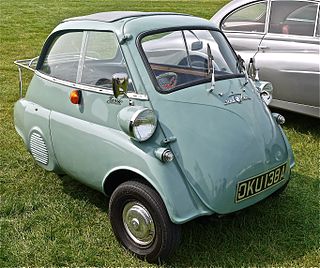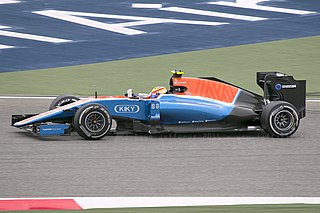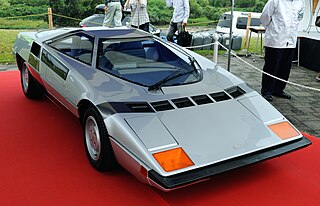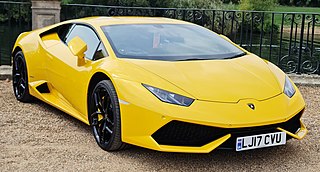Related Research Articles

The Volkswagen Beetle—officially the Volkswagen Type 1, is an economy car that was built by the German company Volkswagen (VW) from 1938 until 2003. It has a rear-engine design with a two-door body style and is intended for five occupants.

Nash Motors Company was an American automobile manufacturer based in Kenosha, Wisconsin from 1916 until 1937. From 1937 through 1954, Nash Motors was the automotive division of the Nash-Kelvinator Corporation. As sales of smaller firms declined after 1950 in the wake of the domestic Big Three automakers advantages in production, distribution, and revenue, Nash merged with Hudson Motors to form American Motors Corporation (AMC). Nash automobile production continued from 1954 through 1957 under AMC.

The Lamborghini Countach is a rear mid-engine, rear-wheel-drive sports car produced by the Italian automobile manufacturer Lamborghini from 1974 until 1990. It is one of the many exotic designs developed by Italian design house Bertone, which pioneered and popularized the sharply angled "Italian Wedge" shape.

The Isetta is an Italian-designed microcar built under license in a number of different countries, including Argentina, Spain, Belgium, France, Brazil, Germany, and the United Kingdom. Because of its egg shape and bubble-like windows, it became known as a bubble car, a name also given to other similar vehicles.

The Holden Monaro is a car which was manufactured by General Motors' Australian division Holden. It has a front-engine, rear-wheel-drive layout and was produced with a two-door coupé body from 1968 to 1975 and again from 2001 to 2006 and with a 4-door sedan body from 1973 to 1977.

The Honda NSX, marketed in North America as the Acura NSX, is a two-seater, rear mid-engined, rear-wheel drive sports car manufactured by Honda.

Front-wheel drive (FWD) is a form of engine and transmission layout used in motor vehicles, in which the engine drives the front wheels only. Most modern front-wheel-drive vehicles feature a transverse engine, rather than the conventional longitudinal engine arrangement generally found in rear-wheel-drive and four-wheel-drive vehicles.

In automotive design, a front-engine, front-wheel-drive (FWD) layout, or FF layout, places both the internal combustion engine and driven roadwheels at the front of the vehicle.
Economy car is a term mostly used in the United States for cars designed for low-cost purchase and operation. Typical economy cars are small, lightweight, and inexpensive to both produce and purchase. Stringent design constraints generally force economy car manufacturers to be inventive. Many innovations in automobile design were originally developed for economy cars, such as the Ford Model T and the Austin Mini.

In automotive engineering, a mid-engine layout describes the placement of an automobile engine in front of the rear-wheel axles, but behind the front axle.

The Ford Territory is a mid-size crossover SUV built by Ford Australia that was introduced in April 2004 and produced until 7 October 2016. It was the only SUV built in Australia and Ford's first large three-row crossover SUV. It was originally based on the EA169 platform introduced by the EA Falcon and its internal project codename was E265. It won various automotive awards and was the first SUV to win the Australian title of Wheels Car of the Year in 2004, due to its acceptable handling and child carrying capacity.

The Dome Zero was a prototype sports car from DOME Co. Ltd that was exhibited at the 48th Geneva Auto Show in 1978. The Dome project, pronounced "do-mu" or "child's dream" in Japanese, was started by Minoru Hayashi in 1975, with the goal of producing sports cars using knowledge gained from auto racing. The Zero was to be their first production road car and Dome planned to produce a limited number for sale in Japan. Despite multiple prototypes and homologation efforts, the Zero was never approved by regulatory bodies for sale in Japan or overseas. As a result, the project was not commercially viable and the Zero never entered series production.
MIEV (Mitsubishi In-wheel motor Electric Vehicle) or MiEV (Mitsubishi innovative Electric Vehicle) is the name given by Japanese automaker Mitsubishi Motors (MMC) to its alternative propulsion technologies. From late 2006, “MiEV” encompasses all of Mitsubishi Motors’s electric drive systems work, including lithium-ion batteries, in-wheel motors and other technologies related to electric vehicle (EV), hybrid-electric vehicle and fuel-cell vehicles.

The ChevroletCorvair Monza GT (XP-777) was a mid-engined experimental prototype automobile built in 1962 and based on the early model Chevrolet Corvair series. As it was essentially a concept car, the Monza GT did not enter production.

A vehicle frame, also historically known as its chassis, is the main supporting structure of a motor vehicle to which all other components are attached, comparable to the skeleton of an organism.

Timoney Technology Limited of Ireland is an Irish company which designs, develops and manufactures powertrains and independent suspension systems for heavy duty trucks, motor coaches and military vehicles. Timoney designs and develops a variety of standard armoured and soft skin mobility systems for military, commercial and specialist applications, principally utilising an independent suspension technology.

The Infiniti Q50 is a compact executive car manufactured by Nissan for its luxury brand, Infiniti. Replacing the G/Q40 sedan, it debuted at the 2013 North American International Auto Show and went on sale in North America in the third quarter 2013 and in Europe in fourth quarter 2013. It is the export model of the Japanese domestic market's V37 Nissan Skyline.

The Lamborghini Huracán is a sports car manufactured by Italian automotive manufacturer Lamborghini replacing the previous V10 offering, the Gallardo. The Huracán was revealed online in December 2013, making its worldwide debut at the 2014 Geneva Auto Show, and was released in the market in the second quarter of 2014.

The Audi R8 is the second generation of the R8 sports car manufactured by German automobile manufacturer Audi. The Type 4S is based on the Lamborghini Huracán and shares its platform and engine. The Type 4S was introduced at the 2015 Geneva Motor Show and its production began in late 2015.
References
- ↑ "The all-African dream machine". BBC NewsThe all-African dream machinex. 17 April 1998. Retrieved 2 February 2015.
- ↑ "Nigerian invents power-generating machine, makes Africa's first local car". Vanguard. 20 September 2012. Retrieved 2 February 2015.
- ↑ "Are these cars really made in Nigeria?". Nigerian Tribune. 9 November 2014. Archived from the original on 9 February 2015. Retrieved 2 February 2015.